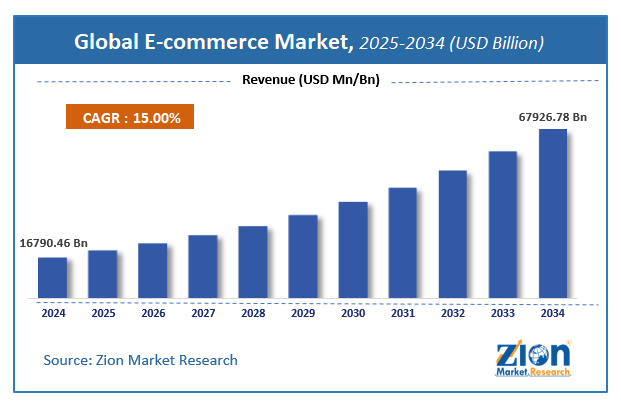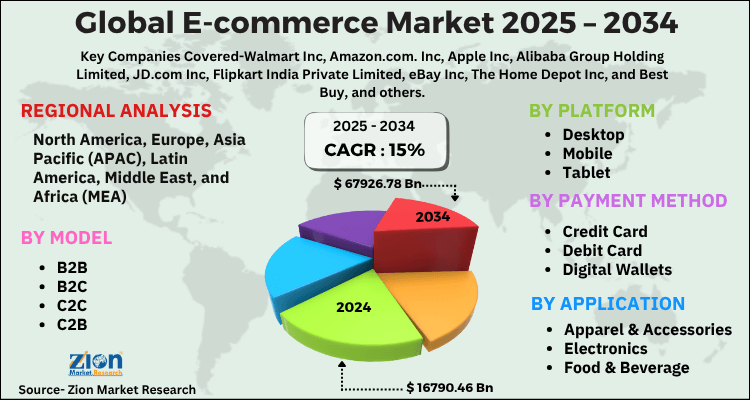Global E-commerce Market Size, Share, Growth Analysis Report - Forecast 2034

E-commerce Market By Model (B2B, B2C, C2C, C2B), By Platform (Desktop, Mobile, Tablet), By Payment Method (Credit Card, Debit Card, Digital Wallets, Bank Transfer, Cash on Delivery), By Application (Apparel & Accessories, Electronics, Food & Beverage, Health & Personal Care, Home & Furniture, Automotive, Books & Media), and By Region: Global and Regional Industry Overview, Market Intelligence, Comprehensive Analysis, Historical Data, and Forecasts 2025 - 2034
| Market Size in 2024 | Market Forecast in 2034 | CAGR (in %) | Base Year |
|---|---|---|---|
| USD 16790.46 Billion | USD 67926.78 Billion | 15% | 2024 |
E-commerce Market: Industry Perspective
The global E-commerce Market size was worth around USD 16790.46 Billion in 2024 and is predicted to grow to around USD 67926.78 Billion by 2034 with a compound annual growth rate (CAGR) of roughly 15% between 2025 and 2034. The report analyzes the global e-commerce market's drivers, restraints/challenges, and the effect they have on the demands during the projection period. In addition, the report explores emerging opportunities in the e-commerce industry. Request Free Sample
Request Free Sample
Global E-commerce Market: Overview
In a competitive marketplace, e-Commerce offers low risk and huge avenues for penetrating global markets. Furthermore, it helps customers in differentiating brands & enhancing customer loyalty. Moreover, online purchases & sales of products will offer retailers an opportunity to have insights into consumer purchasing patterns through captured consumer data. This, in turn, will help retailers target potential customers with help of data patterns & trends. In view of the increase witnessed in tech-savvy consumers, online channels and customer touchpoints can supplement the existing online presence of end-users along with facilitating retailers for quick testing as well as exploring newer markets. Reportedly, D2C or direct-to-consumer E-commerce offers the best opportunities for new brands to create direct relationships with end-users.
Key Insights
- As per the analysis shared by our research analyst, the global e-commerce market is estimated to grow annually at a CAGR of around 15% over the forecast period (2025-2034).
- Regarding revenue, the global e-commerce market size was valued at around USD 16790.46 Billion in 2024 and is projected to reach USD 67926.78 Billion by 2034.
- The e-commerce market is projected to grow at a significant rate due to increasing internet and smartphone penetration, changing consumer shopping behavior, growth in digital payment solutions, and expansion of omnichannel retail strategies.
- Based on Model, the B2B segment is expected to lead the global market.
- On the basis of Platform, the Desktop segment is growing at a high rate and will continue to dominate the global market.
- Based on the Payment Method, the Credit Card segment is projected to swipe the largest market share.
- By Application, the Apparel & Accessories segment is expected to dominate the global market.
- Based on region, North America is predicted to dominate the global market during the forecast period.
E-commerce Market: Report Scope
| Report Attributes | Report Details |
|---|---|
| Report Name | E-commerce Market |
| Market Size in 2024 | USD 16790.46 Billion |
| Market Forecast in 2034 | USD 67926.78 Billion |
| Growth Rate | CAGR of 15% |
| Number of Pages | 180 |
| Key Companies Covered | Walmart Inc, Amazon.com. Inc, Apple Inc, Alibaba Group Holding Limited, JD.com Inc, Flipkart India Private Limited, eBay Inc, The Home Depot Inc, and Best Buy, and others. |
| Segments Covered | By Model, By Platform, By Payment Method, By Application, and By Region |
| Regions Covered | North America, Europe, Asia Pacific (APAC), Latin America, The Middle East and Africa (MEA) |
| Base Year | 2024 |
| Historical Year | 2020 to 2023 |
| Forecast Year | 2025 - 2034 |
| Customization Scope | Avail customized purchase options to meet your exact research needs. Request For Customization |
Global E-commerce Market: Growth Factors
The expansion of e-commerce Market in foreseeable future is subject to a rise in internet penetration and smartphone use across the globe. In addition to this, information about travel & leisure, online content, e-tailing, and financial services is available online on E-commerce sites and this will drive the growth of E-commerce business. Furthermore, the optimum use of new technologies in online business activities and the rise in tech-savvy consumers will open new gates of growth for E-commerce platform market size. Apart from this, a rise in awareness about the benefits of E-commerce activities will create new growth dimensions for E-commerce industry in the coming years. Moreover, the onset of new technologies such as 4G and 5G has enhanced internet speed & connectivity, thereby driving industry trends.
With new network systems offering a seamless experience to end-users, e-commerce Market size is likely to expand by leaps & bounds in the coming years. A rise in online shopping activities will pave a way for the growth of E-commerce market. A rise in consumer income and purchasing capacity will prop up the scope of market growth in the foreseeable future. A prominent spread of the COVID pandemic has resulted in an increase in online purchases of goods, thereby further accelerating industry space.
Global E-commerce Market: Opportunities
The global E-commerce industry refers to the online purchase and sale of goods and services. The Market has experienced rapid growth in recent years, and businesses can take advantage of a number of opportunities:
- Global Reach: With the internet, businesses can now reach customers regardless of their location around the globe. By targeting new markets, businesses can expand their customer base and increase their sales.
- Lower Costs: E-commerce eliminates the need for physical storefronts and reduces the costs associated with conventional retail, including rent, utilities, and personnel. This enables businesses to operate more efficiently and provide customers with lower prices.
- Personalization: E-commerce platforms can collect data on customer preferences and purchasing patterns, enabling businesses to personalise their marketing and product offerings. This can result in increased customer retention and loyalty.
- Mobile Commerce: With the proliferation of smartphones and tablets, an increasing number of customers are making purchases via mobile devices. Businesses that optimise their E-commerce platforms for mobile devices can increase sales by capitalising on this trend.
- New Payment Options: E-commerce has facilitated the creation of new payment methods, such as mobile payments and digital wallets, which offer customers greater convenience and security.
- Integration with Social Media: Social media platforms allow e-commerce industry to reach new customers and promote their products. Social media also provides a platform for customer engagement and feedback, which can assist businesses in enhancing their offerings and fostering stronger customer relationships.
The E-commerce industry analysis provides numerous opportunities for businesses to broaden their reach, reduce expenses, and increase sales. By utilising these opportunities, businesses can maintain their competitiveness in the current global market.
E-commerce Market: Segmentation Analysis
The global e-commerce market is segmented based on Model, Platform, Payment Method, Application, and region.
Based on Model, the global e-commerce market is divided into B2B, B2C, C2C, C2B.
On the basis of Platform, the global e-commerce market is bifurcated into Desktop, Mobile, Tablet.
By Payment Method, the global e-commerce market is split into Credit Card, Debit Card, Digital Wallets, Bank Transfer, Cash on Delivery.
In terms of Application, the global e-commerce market is categorized into Apparel & Accessories, Electronics, Food & Beverage, Health & Personal Care, Home & Furniture, Automotive, Books & Media.
E-commerce Market: Regional Landscape
Asia Pacific Region To Dominate Regional Landscape By 2028
The growth of E-commerce Market size in the Asia Pacific sub-continent in near future can be due to the preference among customers and retailers to make use of B2B tools as an e-commerce platform for performing business activities. Apart from this, the presence of strong business infrastructure in countries such as Japan, Singapore, Taiwan, South Korea, India, and China is likely to benefit the growth of e-commerce market in the region. In addition to this, a large-scale surge in the number of internet users in these countries will define the expansion of E-commerce business in the sub-continent. The rise in B2B deals will culminate in massive demand for E-commerce activities and this will spearhead the progress of the Asia Pacific e-commerce market. The rise in the need for online promotions will boost regional market trends.
E-commerce Market: Competitive Analysis
The report provides a company market share analysis to give a broader overview of the key market players. In addition, the report also covers key strategic developments of the market, including acquisitions & mergers, new product launches, agreements, partnerships, collaborations & joint ventures, research & development, and regional expansion of major participants involved in the e-commerce market on a global and regional basis.
The global e-commerce market is dominated by players like:
- Walmart Inc
- Amazon.com. Inc
- Apple Inc
- Alibaba Group Holding Limited
- JD.com Inc
- Flipkart India Private Limited
- eBay Inc
- The Home Depot Inc
- and Best Buy
The global E-commerce Market is segmented as follows:
By Model Type
- B2B
- B2C
By Offering
- Beauty & Fashion Products
- Pharmaceutical Products
- Travel & Tourism
- Electronic Products
- Household Products
- Food & Beverages
By Region
- North America
- The U.S.
- Canada
- Europe
- France
- The UK
- Spain
- Germany
- Italy
- Rest of Europe
- Asia Pacific
- China
- Japan
- India
- South Korea
- Southeast Asia
- Rest of Asia Pacific
- Latin America
- Brazil
- Mexico
- Rest of Latin America
- Middle East & Africa
- GCC
- South Africa
- Rest of Middle East & Africa
Table Of Content
Methodology
FrequentlyAsked Questions
The global e-commerce market is expected to grow due to increasing internet and smartphone penetration, changing consumer shopping behavior, growth in digital payment solutions, and expansion of omnichannel retail strategies.
According to a study, the global e-commerce market size was worth around USD 16790.46 Billion in 2024 and is expected to reach USD 67926.78 Billion by 2034.
The global e-commerce market is expected to grow at a CAGR of 15% during the forecast period.
North America is expected to dominate the e-commerce market over the forecast period.
Leading players in the global e-commerce market include Walmart Inc, Amazon.com. Inc, Apple Inc, Alibaba Group Holding Limited, JD.com Inc, Flipkart India Private Limited, eBay Inc, The Home Depot Inc, and Best Buy, among others.
The report explores crucial aspects of the e-commerce market, including a detailed discussion of existing growth factors and restraints, while also examining future growth opportunities and challenges that impact the market.
RelatedNews
HappyClients
Zion Market Research
Tel: +1 (302) 444-0166
USA/Canada Toll Free No.+1 (855) 465-4651
3rd Floor,
Mrunal Paradise, Opp Maharaja Hotel,
Pimple Gurav, Pune 411061,
Maharashtra, India
Phone No +91 7768 006 007, +91 7768 006 008
US OFFICE NO +1 (302) 444-0166
US/CAN TOLL FREE +1 (855) 465-4651
Email: sales@zionmarketresearch.com
We have secured system to process your transaction.
Our support available to help you 24 hours a day, five days a week.
Monday - Friday: 9AM - 6PM
Saturday - Sunday: Closed






